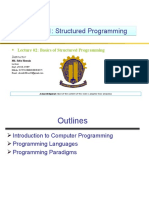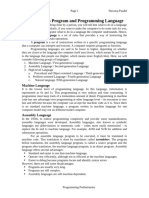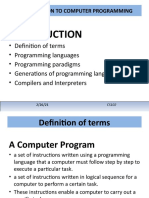0 ratings0% found this document useful (0 votes)
133 viewsTOPIC7LectureNotesSC015 PDF
This document provides an introduction to programming, including defining key concepts like programming languages, paradigms, and language translators. It discusses the three main programming paradigms - procedural, object-oriented, and logic - and describes their approaches. It also defines compilers, interpreters, and assemblers as the three main types of language translators that convert source code into machine-readable format.
Uploaded by
John LowCopyright
© © All Rights Reserved
Available Formats
Download as PDF, TXT or read online on Scribd
0 ratings0% found this document useful (0 votes)
133 viewsTOPIC7LectureNotesSC015 PDF
This document provides an introduction to programming, including defining key concepts like programming languages, paradigms, and language translators. It discusses the three main programming paradigms - procedural, object-oriented, and logic - and describes their approaches. It also defines compilers, interpreters, and assemblers as the three main types of language translators that convert source code into machine-readable format.
Uploaded by
John LowCopyright
© © All Rights Reserved
Available Formats
Download as PDF, TXT or read online on Scribd
You are on page 1/ 19
SC015 COMPUTER SCIENCE
Unit Sains Komputer
Kolej Matrikulasi Kedah
7.0 Introduction to Programming
At the end of this topic, students should be able
to:
(a) Define programming language, programming
paradigm and language translators.
(b) Differentiate paradigm of programming
language; procedural, object oriented and
logic
(c) Differentiate types of language translators
(Compiler, Interpreter and Assembler)
Program and Programming
• Program is set of instructions that tells a
computer to perform tasks.
– Instructions must be written in a way that the
computer can understand.
– Created by a programmer using a programming
language.
• Programming is instructing a computer to do
something for you with the help of a
programming language.
Programming Language
• A set of words, symbols and codes that
enables a programmer to give instructions to a
computer.
• A set of commands that a computer has been
“taught” to understand.
• contains instructions for the computer to
perform a specific action or a specific task.
Types of Programming Language
• Low level language
– consists of strings of binary digits or English-like
abbreviations to represent instructions to
computer
• High level language
– Consists of a series of English-like words to
represent instructions to computer
Programming Paradigm
• Programming languages are categorized
according to the approach they use to solve a
problem.
• A paradigm is a way in which a programming
language looks at the problem to be solved.
Three (3) Programming Paradigm
• Procedural
• Object Oriented
• Logic
Procedural
• Programming paradigm which based upon the
concept of procedure calls, in which
statements are structured into procedures
(also known as subroutines or functions).
• Procedure calls are modular and are bound by
scope.
Object Oriented
• Programming paradigm which is based on the
concept of objects.
• Programmer identify objects which are items
that can contain both data and the procedures
that read or manipulate that data.
• Data and procedures are encapsulated.
Object Oriented
• An object is an item that can contain both
data and the procedures that read or
manipulate that data.
• An object represents a real person, place,
event, or transaction.
• Example of an object :
– Employee object– may consists employee’s name,
age, address, phone number, salary no.,
department, and salary
Object Oriented
• For example, the payroll program and health
benefits program both use the Employee object.
• That is, the payroll program would use it to
process employee pay checks and the health
benefits program would use it to process health
insurance payments
• Once programmer creates an Employee object, it
is available for use by any other existing or future
program.
• Programmer may reuse objects repeatedly.
Object Oriented
• Advantages:
– the ability to reuse and modify existing objects
– avoid programming redundancy
– programmers create applications faster
• Examples of OOP language:
– C++ , Java, Visual Basic
Logic
• Programming paradigm which is largely based
on formal logic.
• Any program written in a logic programming
language is a set of sentences in logical form,
expressing facts and rules about some
problem domain.
Language Translators
• A special program that translates
programming source code into machine
language.
Types of Language Translators
• Compiler
• Interpreter
• Assembler
Compiler
• A program that translates the entire source
code of high-level programming language into
machine language.
Interpreter
• A program that translates high-level
programming language into machine language
one line at a time.
Assembler
• A program that translates assembly language
to machine language.
End of SC015 Notes
You might also like
- 2.introduction and Definition of Terms.No ratings yet2.introduction and Definition of Terms.10 pages
- Module 13 Overview of Computer ProgrammingNo ratings yetModule 13 Overview of Computer Programming32 pages
- Programming Languages, Technologies and ParadigmsNo ratings yetProgramming Languages, Technologies and Paradigms66 pages
- Object Oriented Programming F.Y. MCA Semester INo ratings yetObject Oriented Programming F.Y. MCA Semester I246 pages
- chapter 11 intro to programming_241209_154644No ratings yetchapter 11 intro to programming_241209_15464440 pages
- 1.0 Introduction To Programming 2022 2023 A (FINAL)No ratings yet1.0 Introduction To Programming 2022 2023 A (FINAL)24 pages
- COMP102-Introduction-to-programming-Slides_160380No ratings yetCOMP102-Introduction-to-programming-Slides_16038036 pages
- GRADE - 9 - Introduction To Programming LanguagesNo ratings yetGRADE - 9 - Introduction To Programming Languages7 pages
- Part 1 - Paradigms, Levels, and Importance of ProgrammingNo ratings yetPart 1 - Paradigms, Levels, and Importance of Programming23 pages
- CS 121 - Object Oriented Programming (Lec 1)No ratings yetCS 121 - Object Oriented Programming (Lec 1)22 pages
- Introduction To Programming Paradigm Bsit 1aNo ratings yetIntroduction To Programming Paradigm Bsit 1a9 pages
- Program: Lesson 1 Program and ProgrammingNo ratings yetProgram: Lesson 1 Program and Programming64 pages
- By: Madam Noraini Binti Desa Jke, Polisas 2014: DEC 2012 Fundamental ProgrammingNo ratings yetBy: Madam Noraini Binti Desa Jke, Polisas 2014: DEC 2012 Fundamental Programming36 pages
- Introduction to Programming Languages(UT)No ratings yetIntroduction to Programming Languages(UT)5 pages
- Chapter One: Introduction To Computers, Programs, and JavaNo ratings yetChapter One: Introduction To Computers, Programs, and Java49 pages
- DFC1023 - Problem Solving &program Design: Introduction To Programming LanguageNo ratings yetDFC1023 - Problem Solving &program Design: Introduction To Programming Language22 pages
- L01 - 30.01.2018 - Basics of Structured ProgrammingNo ratings yetL01 - 30.01.2018 - Basics of Structured Programming28 pages
- Programming Paradigms: Unit 1 - Introduction and Basic ConceptsNo ratings yetProgramming Paradigms: Unit 1 - Introduction and Basic Concepts33 pages
- COMPUTER PROGRAMMING FOR KIDS: An Easy Step-by-Step Guide For Young Programmers To Learn Coding Skills (2022 Crash Course for Newbies)From EverandCOMPUTER PROGRAMMING FOR KIDS: An Easy Step-by-Step Guide For Young Programmers To Learn Coding Skills (2022 Crash Course for Newbies)No ratings yet
- Input and Output Text and Binary I/O: Introduction To Java Y.Daniel Liang 1No ratings yetInput and Output Text and Binary I/O: Introduction To Java Y.Daniel Liang 164 pages
- CH 02.machine Structure Machine Language Assembly LanguageNo ratings yetCH 02.machine Structure Machine Language Assembly Language11 pages
- Tutorial Letter 201/2/2012: Introduction To Programming II Semester 2No ratings yetTutorial Letter 201/2/2012: Introduction To Programming II Semester 218 pages
- Full Part - CSE Bulletin - Final VersionNo ratings yetFull Part - CSE Bulletin - Final Version67 pages
- Applications Developer Job Profile - Prospects - Ac.ukNo ratings yetApplications Developer Job Profile - Prospects - Ac.uk6 pages
- Project Report On Employee Management System - Edited (1) - Edited (1) - EditedNo ratings yetProject Report On Employee Management System - Edited (1) - Edited (1) - Edited30 pages
- v125 Programmable Terminal Na-Series (v1) Users Manual enNo ratings yetv125 Programmable Terminal Na-Series (v1) Users Manual en188 pages
- Chapter 6 Iot Systems Logical Design Using PythonNo ratings yetChapter 6 Iot Systems Logical Design Using Python33 pages
- Computer: A Computer Is A Multipurpose Programmable Machine That ReadsNo ratings yetComputer: A Computer Is A Multipurpose Programmable Machine That Reads3 pages
- Introduction To Java: Eng. Qusai F. BakerNo ratings yetIntroduction To Java: Eng. Qusai F. Baker30 pages
- 1.0 Introduction To Programming 2022 2023 A (FINAL)1.0 Introduction To Programming 2022 2023 A (FINAL)
- Part 1 - Paradigms, Levels, and Importance of ProgrammingPart 1 - Paradigms, Levels, and Importance of Programming
- By: Madam Noraini Binti Desa Jke, Polisas 2014: DEC 2012 Fundamental ProgrammingBy: Madam Noraini Binti Desa Jke, Polisas 2014: DEC 2012 Fundamental Programming
- Chapter One: Introduction To Computers, Programs, and JavaChapter One: Introduction To Computers, Programs, and Java
- DFC1023 - Problem Solving &program Design: Introduction To Programming LanguageDFC1023 - Problem Solving &program Design: Introduction To Programming Language
- L01 - 30.01.2018 - Basics of Structured ProgrammingL01 - 30.01.2018 - Basics of Structured Programming
- Programming Paradigms: Unit 1 - Introduction and Basic ConceptsProgramming Paradigms: Unit 1 - Introduction and Basic Concepts
- Programming And Coding in Intermidiate LevelFrom EverandProgramming And Coding in Intermidiate Level
- COMPUTER PROGRAMMING FOR KIDS: An Easy Step-by-Step Guide For Young Programmers To Learn Coding Skills (2022 Crash Course for Newbies)From EverandCOMPUTER PROGRAMMING FOR KIDS: An Easy Step-by-Step Guide For Young Programmers To Learn Coding Skills (2022 Crash Course for Newbies)
- Input and Output Text and Binary I/O: Introduction To Java Y.Daniel Liang 1Input and Output Text and Binary I/O: Introduction To Java Y.Daniel Liang 1
- CH 02.machine Structure Machine Language Assembly LanguageCH 02.machine Structure Machine Language Assembly Language
- Tutorial Letter 201/2/2012: Introduction To Programming II Semester 2Tutorial Letter 201/2/2012: Introduction To Programming II Semester 2
- Applications Developer Job Profile - Prospects - Ac.ukApplications Developer Job Profile - Prospects - Ac.uk
- Project Report On Employee Management System - Edited (1) - Edited (1) - EditedProject Report On Employee Management System - Edited (1) - Edited (1) - Edited
- v125 Programmable Terminal Na-Series (v1) Users Manual env125 Programmable Terminal Na-Series (v1) Users Manual en
- Computer: A Computer Is A Multipurpose Programmable Machine That ReadsComputer: A Computer Is A Multipurpose Programmable Machine That Reads

























































































